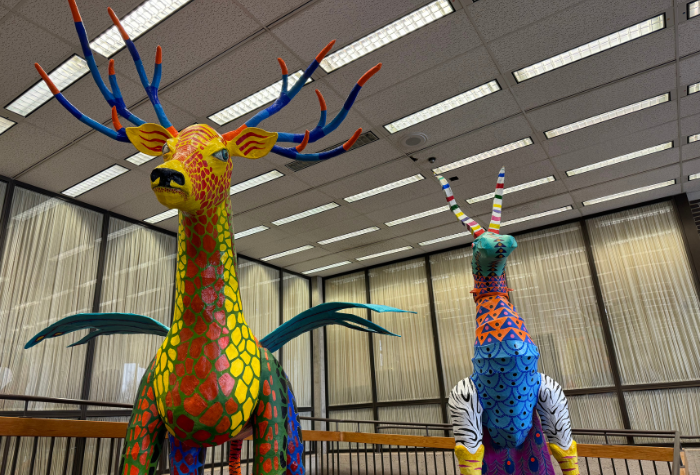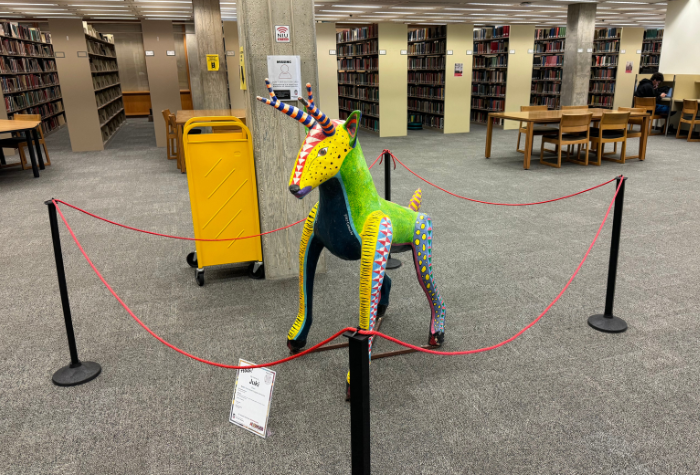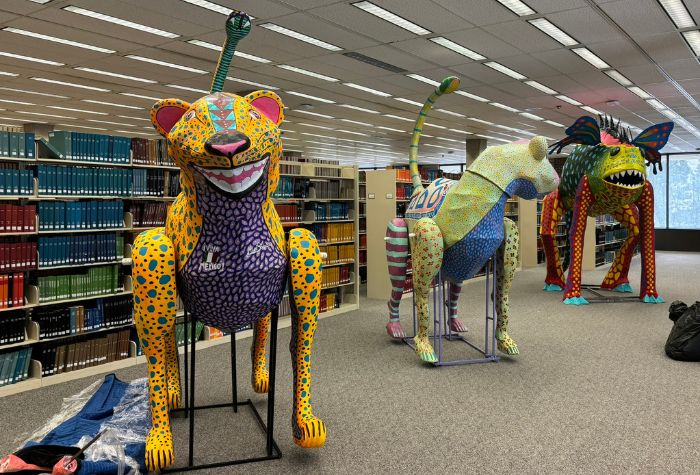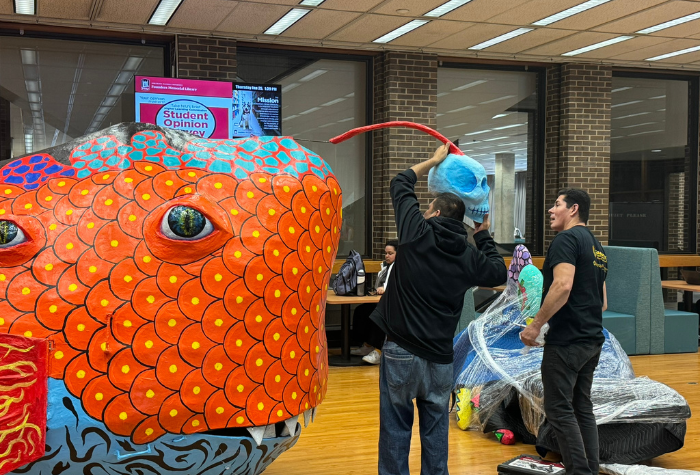Welcome to the Alebrijes Exhibit
This exhibit presents original Mexican folk art in the alebrijes tradition. It includes 22 pieces created by five artists from Mexico City. The DuPage Mexican Cultural Center in West Chicago selected the pieces and provided them to Northern Illinois University Library.
La exhibición presenta una colección de 22 piezas creadas por cinco artistas de Ciudad de México. El DuPage Mexican Cultural Center en West Chicago seleccionó las piezas y las envió a la biblioteca.
Northern Illinois University Libraries will present the following public programs in the Fall of 2024
The History of Alebrijes
Alebrijes are brightly colored folk depictions of magical beings. Many people believe alebrijes represent a long Mexican folk art tradition, but in fact they only began to appear in the 1940s. The well- known Mexican artist Pedro Linares (1906-1992) invented the form, and its name. He often told a story about how he came to create alebrijes. While in bed with a fever, Linares dreamed of incredible creatures combining the features of different animals. The creatures began chanting a single nonsense word: alebrije… alebrije… alebrije! This frightening scene awakened Linares and when his fever subsided, he began constructing what he had seen in his dream. He called these sculptures alebrijes.
Linares had already built a career working in paper mache, creating pinatas, masks, and Judas figures used in Easter celebrations. He built his first alebrijes with this material. Observers found his original pieces disturbing and they attracted no buyers. After a time, a prominent art gallery owner noticed Linares’ creations, and went on to market them successfully. Linares’ alebrijes then became very well-known, and the celebrated Mexican artists Diego Rivera and Frida Kahlo commissioned pieces for their private collections.
Today, alebrijes created in many regions of Mexico can be found in private and museum collections around the world. Alebrijes also appeared in the 2017 Disney film Coco. As the alebrijes tradition has developed, Mexican artists have continued to construct them in a variety of media, including paper mache and wood. This collection consists of materials developed from the tradition of paper mache, which produces pieces at a larger scale than woodcarving. Many artists working in this medium now incorporate additional materials, such as acrylic, in order to enhance the pieces’ durability.
Los alebrijes son representaciones populares y coloridas de criaturas mágicas. Muchas personas creen que los alebrijes representan una tradición del arte popular mexicano, pero estos aparecieron apenas en los años 40. El reconocido artista mexicano, Pedro Linares (1906-1992), inventó y nombró este estilo. A menudo contaba la historia sobre cómo creó los alebrijes. En una ocasión, mientras se encontraba en cama por una fiebre, Linares soñó con unas criaturas increíbles que poseían características de distintos animales. Las criaturas cantaban una palabra sinsentido: ¡alebrije… alebrije… alebrije! Esta escena aterradora lo despertó y, al recuperarse de la fiebre, comenzó a esculpir lo que había visto en su sueño. Llamó a estas esculturas “alebrijes”.
Linares ya tenía una carrera establecida creando piñatas, máscaras y figuras de Judas en papel maché para las celebraciones de pascua, y fue con este material que esculpió sus primeros alebrijes. Los espectadores consideraron que sus piezas eran perturbadoras y no consiguió muchos compradores. Después de un tiempo, una importante galería de arte se percató de las creaciones de Linares y comenzó a promocionarlas de manera exitosa. Los alebrijes de Linares se volvieron muy populares, y artistas reconocidos como Diego Rivera y Frida Kahlo encargaron algunas piezas para sus colecciones privadas.
Actualmente se pueden encontrar alebrijes de diversas regiones de México en colecciones privadas y de museos a nivel mundial. Los alebrijes también aparecieron en la película de Disney del 2017, Coco. A medida que creció la tradición de los alebrijes, los artistas mexicanos continuaron esculpiéndolos con distintos materiales, como el papel maché y la madera. La colección que se exhibe en la Founders Memorial Library está formada por materiales provenientes de la tradición de la escultura en papel maché, lo que permite crear piezas a mayor escala, a diferencia del tallado en madera. Muchos artistas del medio actualmente incorporan materiales adicionales, como el acrílico, con el fin de aumentar la durabilidad de las piezas.
- Browse Creatures / Explorar Criaturas
- Group or Class Visits / Visitas de Grupo o Clase
- Maps / Mapas
- Meet the Artists / Conocer a los Artistas
Co-Sponsors
We would like to thank all of our amazing co-sponsors. Without them this exhibit would not have been possible. Thank you very much!
- Center for Latino and Latin American Studies
- Division of Outreach Engagement and Regional Development (OERD)
- Friends of the NIU Libraries
- Latino Resource Center
Sneak Peek of the Exhibit





Content courtesy of Cantigny Park. For exclusive use by Northern Illinois University.
